The Indian sub-continent is home to mountain ranges, hill stations and soaring peaks higher than 3000 m. The Himalayan mountain ranges in India are the most famous mountain ranges, home to the tallest peaks in the world. There are more than 100 peaks that are higher than 7000 m spread across India, Pakistan, Nepal, China and Bhutan. The highest peak in India is Kanchenjunga mountain which is 8586 m high and is in Sikkim.
Only two mountains are taller than Kanchenjunga – Everest (8848 m) and K2 (8611 m). The Himalayan mountain range consists of three parallel ranges: Greater Himalayas, Lesser Himalayas and Outer Himalayas. In India, the Himalayas extends for more than 2500 km from west to east. Other tall mountains in India can be found in the Trans Himalayas, Purvachal Himalayan ranges and the Western Ghats. India also has many smaller peaks and older mountain ranges which are home to many beautiful hill stations, tea and coffee plantations, evergreen forests and more.
The mountains of India are sacred and revered, many mountains are considered the abode of gods, especially peaks in the Himalayan region. Pilgrimage destinations are nestled within the mountains. And Hindu pilgrimage tours (Yatras) are organised by specialist tour operators organise to visit these pilgrimage destinations. Many Indians consider it auspicious to complete a Yatra, and those who complete the especially difficult Yatras are revered in their community.
Contents
Mountains In India
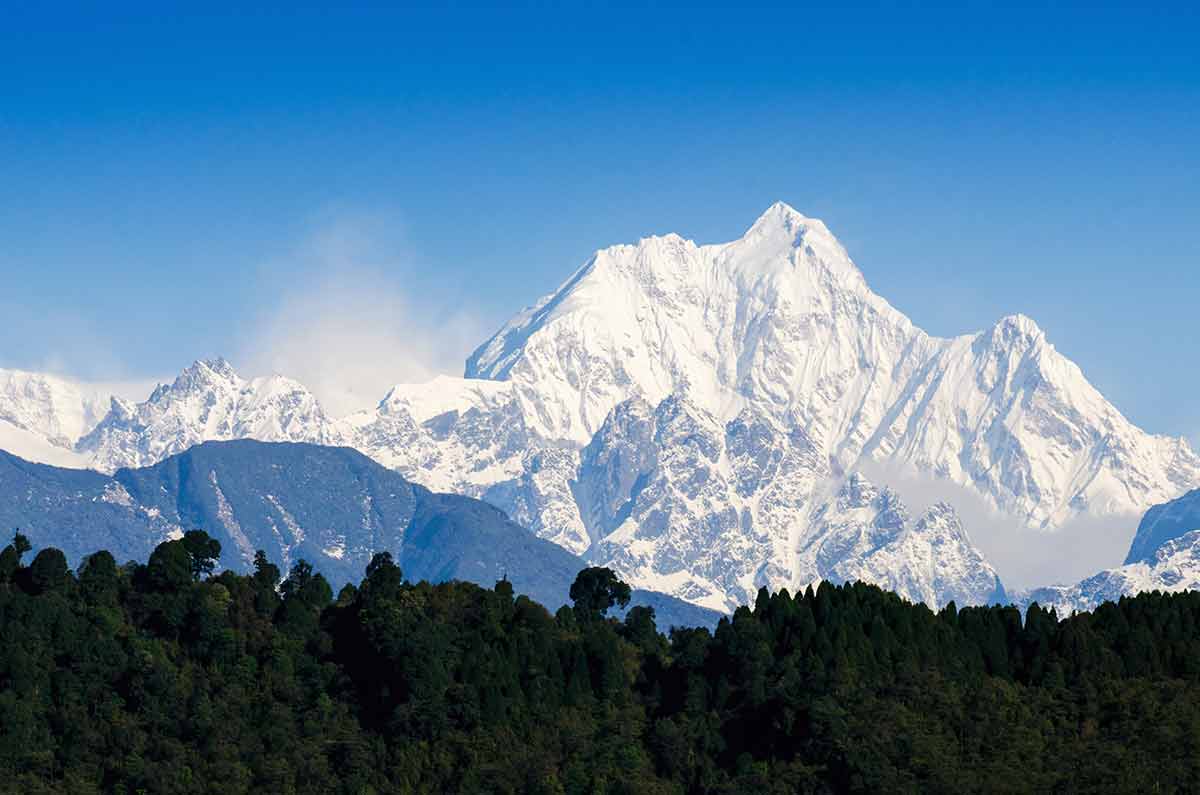
10 Highest Mountains In India
Mount Kangchenjunga – 8,598m/28,209 ft
Mount Nanda Devi – 7,816m/25,643 ft
Mount Kamet – 7,756m/25,446 ft
Saltoro Kangri/K10 – 7,742m/25,400 ft
Saser Kangri I/K22 – 7,672m/25,170 ft
Mamostong Kangri/K35 – 7,516m/24,658 ft
Saser Kangri II E – 7,513m/24,649 ft
Saser Kangri III – 7,495m/24,590 ft
Teram Kangri I – 7,462m/24,482 ft
Jongsong Peak – 7,462m/24,482 ft
23 Things To Do In The Indian Mountains
The Himalayan Ranges
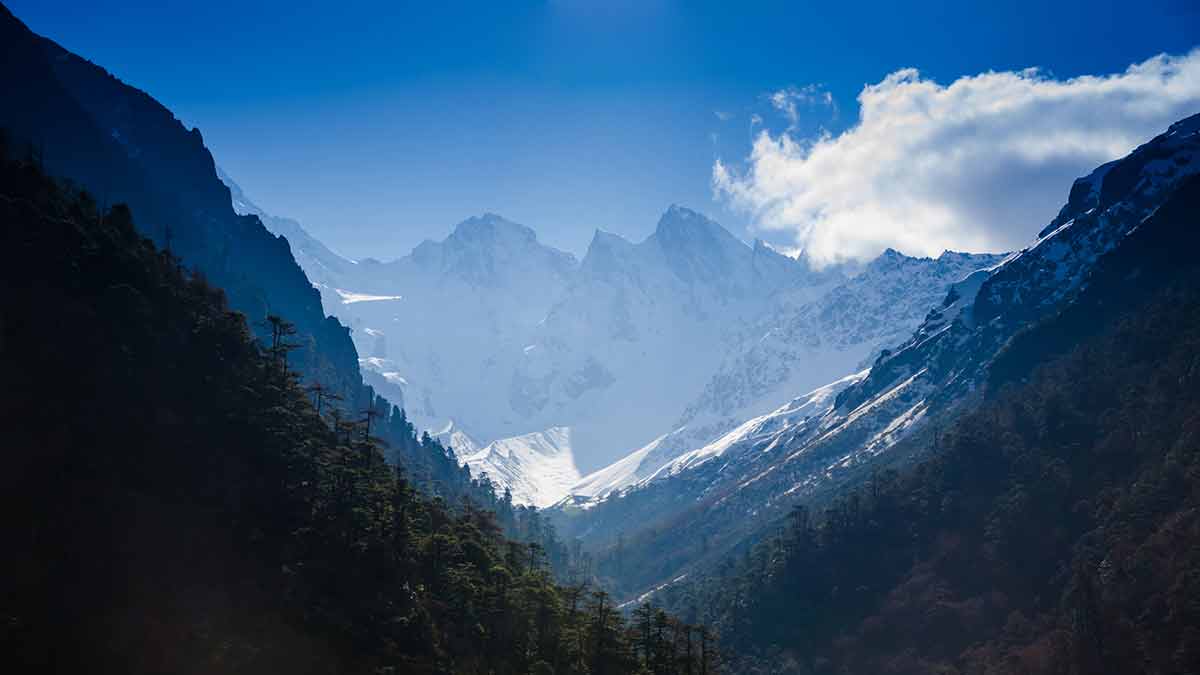
The Himalayan Ranges are the tallest and youngest mountains in the world. The word “Himalaya” translates to “abode of snow” in Sanskrit – “Hima” means snow, and “alaya” means abode or dwelling.
When viewed from a distance, most of the Himalayan ranges are enormous, awe-inspiring snowy mountains.
The Himalayas extend 2500 km from Afghanistan and pass through the Indian states of Jammu and Kashmir in the west to Arunachal Pradesh and Manipur in the east.
Ladakh, Himachal Pradesh, Uttarakhand, Sikkim and West Bengal are the other Indian states through which the Himalayan mountain ranges pass through.
Due to the continuous movement of the Indian tectonic plate towards the Eurasian plate, the Himalayan mountains are still rising higher.
Everest and many of the tallest peaks are rising by a few millimetres yearly. Many perennial, glacier-fed rivers originate in the Himalayan regions and flow through large parts of India, Bangladesh and Pakistan to flow to the oceans.
The Himalayan ranges consist of parallel, converging ranges separated by deep valleys.
The Himalayas lie between Tibet and Gangetic Plain and consist of three parallel mountain ranges called the Greater Himalayas (or Himadri or Central Himalayas), Middle Himalayas (also called Himachal or Lower Himalayas) and Outer Himalayas (also called Shivalik ranges).
The Greater Himalayas is the highest zone bordering the Tibetan Plateau and has lofty snow-covered peaks with an average elevation of 6100 m.
The Greater Himalayas are home to many of the world’s tallest peaks, such as Everest and Kanchenjunga. These mountain ranges are snow-clad throughout the year and have many high-altitude trekking routes, breathtaking glacier lakes and motorable mountain passes.
The Greater Himalayas pass through Indian States of Himachal Pradesh, Uttarakhand, Sikkim and Arunachal Pradesh.
Middle Himalayas are mountain ranges in the second belt of the Himalayan mountain system parallel to the Greater Himalayas. The elevation of most of the mountain peaks ranges from 3600 m to 4600 m, with deep valley gorges.
The two major mountain ranges in the Middle Himalayas are the Pir Panjal and Dhauladar Ranges. These ranges are home to many river systems fed by the glaciers and snowfields in the Greater Himalayan mountain ranges.
The mountain peaks in this region are considered sacred by Hindus, and many pilgrimage places such as Kedarnath, Gangotri, and Amarnath caves, among others.
You can visit many ski resorts, hill stations and National Parks in these ranges. Popular trekking routes are available with a lower difficulty level than treks in Greater Himalayas.
Most of the Himalayan hill stations like Gulmarg, Shimla, Manali, Ranikhet, Darjeeling and others are in the Middle Himalayas.
Outer Himalayas are the southernmost of the three belts in the Himalayan mountain system.
The average elevation of most mountain peaks in this range is below 2000 m. Unlike the Greater and Middle Himalayan mountains, the Outer Himalayas range narrows as it moves east and is hardly discernible beyond West Bengal and Sikkim.
These mountains are much more accessible, but the forest cover reduces towards the west.
Highest Peak: Kanchenjunga, Sikkim (8,586 meters or 28,169 ft).
Things To Do In the Himalayas include:
Also read: 70 Mountain Quotes For Inspiration
1- Visit A High-Altitude Mountain Pass
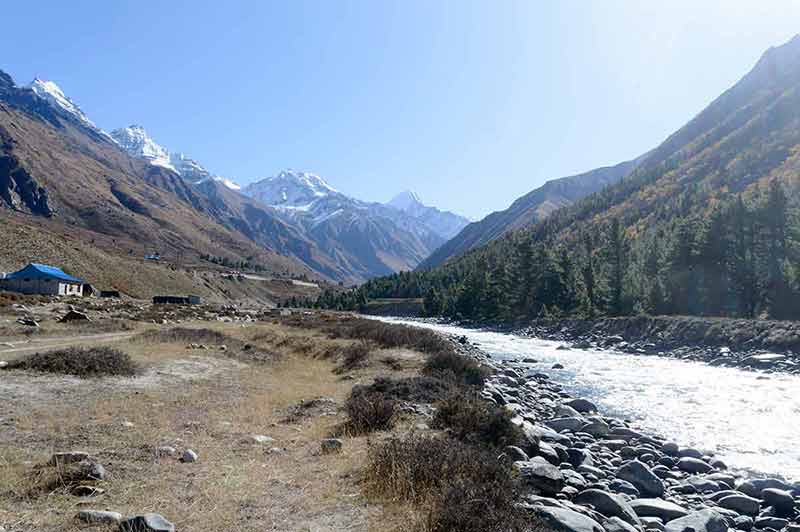
India is home to many high-altitude mountain passes such as Nathu La in Sikkim, Zoji La in Jammu and Kashmir and Shipki La in Himachal Pradesh.
These passes are popular as many are connected by road and can be reached by vehicle.
Many of these passes are snowbound most of the year and are prone to rockfall and snowfall.
You can rent a two-wheeler or four-wheeler vehicle to explore the mountain roads in the Himalayas.
Exploring the amazing views and experiencing the mountains often requires crossing from one mountain to another via a mountain pass, and this should be on your bucket list while travelling to the Himalayas.
2- Explore A Himalayan Village
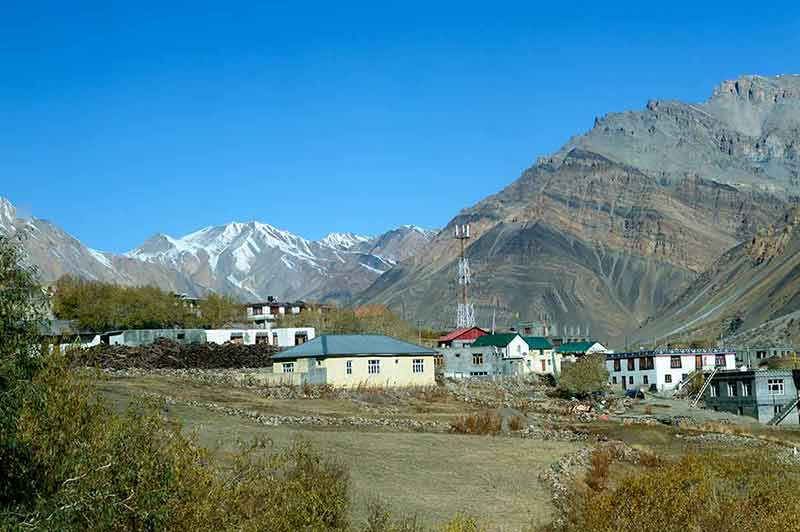
Hundreds of tiny villages are nestled in the valleys among the towering peaks of the Himalayas.
Most of these villages will never be far from an Indian Army outpost, and you can find many of them on maps.
While exploring the Himalayas, visiting a remote and secluded village and experiencing the tranquillity of village life will kindle your spiritual side.
Kibber village in Spiti Valley, Panikhar village in Suru Valley, Lachen village in Sikkim are some of the idyllic Himalayan villages.
3- Be Amazed At The Beauty Of A High-Altitude Lake
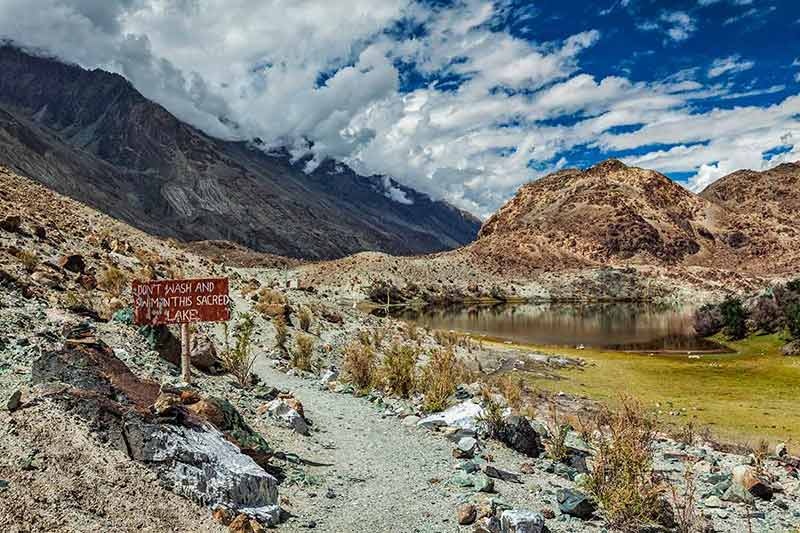
Many high-altitude lakes are nestled in the valleys beside mountains and glaciers across the Greater Himalayan Ranges.
Gurudongmar Lake in Sikkim is fed by melted water from glaciers and surrounded by snow-capped mountain peaks.
The picturesque view of the lake (which completely freezes in winter) amidst mountains is truly a memorable sight.
Pangong Lake near Leh in Ladakh is another popular high-altitude lake in the India-China border.
4- Travel On The Toy Train in Darjeeling
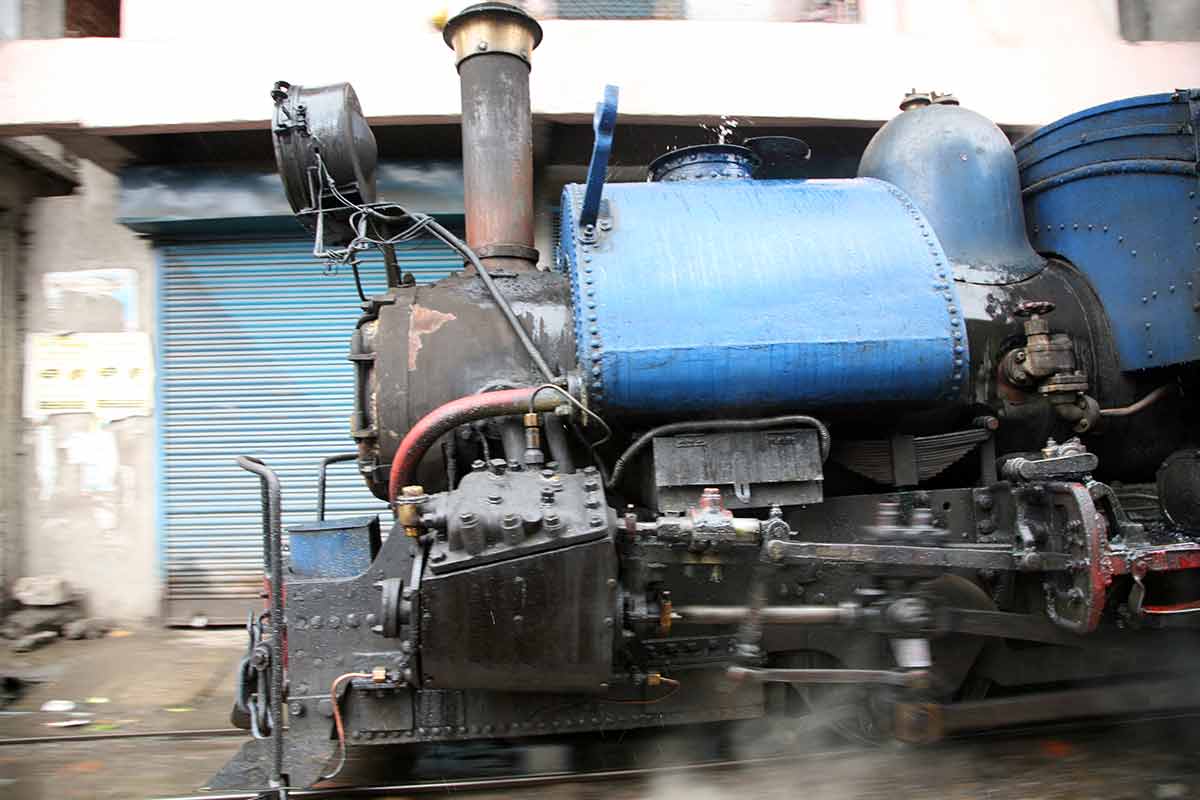
Embark on a train journey where a diesel or a steam engine pulls coaches on a narrow-gauge track through tea plantations and steep mountain slopes with picturesque views of snow-capped mountains and lush green valleys.
The train ferries between Darjeeling station and Ghum station but requires booking in advance during tourist season due to high demand.
5- Ski The Slopes Of Auli, Uttarakhand
Auli is a ski destination nestled among the towering Himalayan peaks.
The ski resort is close to Valley of Flowers National Park and has a range of accommodations for everyone.
The ski resort has ski-worthy slopes during winter, transforming into a hill station in summer.
Trans Himalayan Ranges
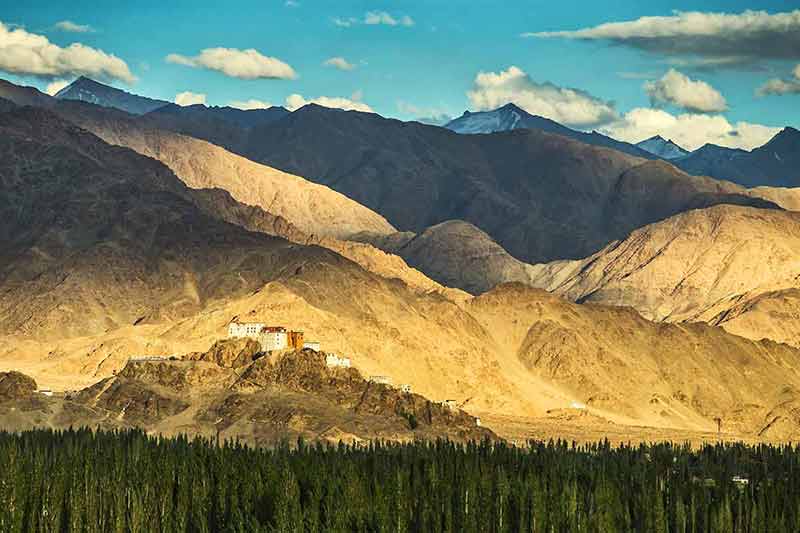
These mountains are part of the Himalayas immediately north and parallel to the Greater Himalayan Ranges.
The Trans Himalayan Ranges comprise of Karakoram, Zanskar and Ladakh Ranges and are geographically located in India, Pakistan and the Tibetan Plateau to the northwest and south of the Greater Himalayan Range.
Two of the 10 tallest mountain peaks in the world – K2 and Nanga Parbat – are located in Karakoram.
A major portion of the Karakoram Ranges lies in the disputed region between India and Pakistan, with both countries claiming this region.
One of the many interesting tidbits about Karakoram Ranges is that they have the most significant number of glaciers, excluding Polar Regions.
The Ladakh Range lies to the south of the Karakoram Range and is home to the Nubra Valley and the high-altitude city of Leh.
This range is famous for its stark mountain slopes, sparse vegetation, and rugged landscapes interspersed with water streams.
Umling La (5883 meters), Marsimek La (5582 meters), and Khardung La (5359 meters) are some of the highest motorable passes in the world which can be reached by a vehicle.
South of the Ladakh Range lies the Zanskar Range in the Indian State of Jammu and Kashmir.
The peaks in this range are taller than those in Ladakh Range, and the climate is harsher.
Many water streams freeze in the winter, and locals use the frozen passages for transportation during cold months when mountain roads are no longer accessible.
The Chadar Frozen River Trek is one of India’s most famous and difficult treks and attracts international trek enthusiasts every year.
Many rivers flow through this region, and the beautiful ski resort of Gulmarg lies in this region. Trekking in this region requires permits from the Indian Government.
Highest Peak: K2 (8611 meters or 28,251 ft), Jammu and Kashmir.
Things to Do in Trans Himalayan Ranges include:
6- Visit Buddhist Monasteries
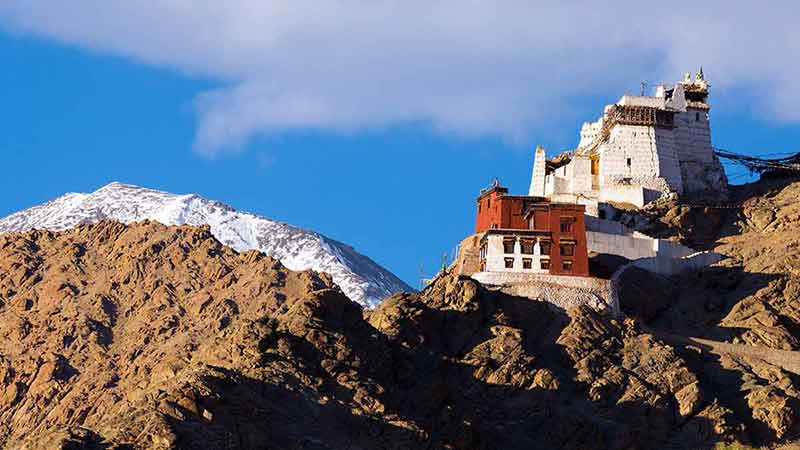
You can visit many Buddhist Monasteries when travelling to the Zanskar, Karakoram and Ladakh regions.
The tranquil atmosphere of a monastery amidst breathtaking landscapes and understanding monks’ way of life will surely calm your soul.
Phuktal Gompa, one of Zanskar’s beautiful cave monasteries, was built centuries ago on a hillside and is located in the remote Lugnak Valley.
You can visit this monastery on foot, a day’s hike from the nearest village.
7- Trek On A Frozen River
The temperatures in the mountains fall to sub-zero in winter, leading to many water streams and rivers freezing up.
Zanskar Valley’s Chadar River Trek, a walking route locals use during winter, is an amazing experience for adventure seekers.
Camping and trekking on the frozen river, natural caves in the mountain, sheer cliff faces, and frozen waterfalls, which would otherwise be gushing with tons of water, are some memorable experiences this trek will offer.
8- Drive To High-Altitude Motorable Mountain Passes
Ladakh region is home to many motorable passes, including the world’s highest drivable pass Umling La, at 5883 m.
The pass is open from June to September and closed due to ice and inclement weather in the other months.
The views from the pass are out of this world due to an absence of vegetation and civilisation, it’s like standing on a mountain on Mars.
You will require a permit from the Indian Government to reach this pass and need to plan well in advance.
Purvachal Mountain Ranges
Purvachal, also known as the Eastern Highlands, are mountains in the northeastern Indian States of Arunachal Pradesh, Nagaland, Mizoram, Manipur, Tripura, Meghalaya and Assam.
These mountain ranges run south of the Brahmaputra valley along the eastern boundary of Myanmar.
Purvachal is an extension of the Himalayan ranges in the east and are characterised by diverse tropical and temperate evergreen vegetation.
The tribal culture, nature, flora and fauna endemic to these mountain ranges attract visitors throughout the year.
Namdapha National Park and Keibul Lamjao National Park can be visited for jungle safaris, trekking and bird watching.
Highest Peak: Dapha Bum (4,578 meters or 15,020 ft).
Things to do in Purvachal Ranges include:
9- Visit Namdapha National Park
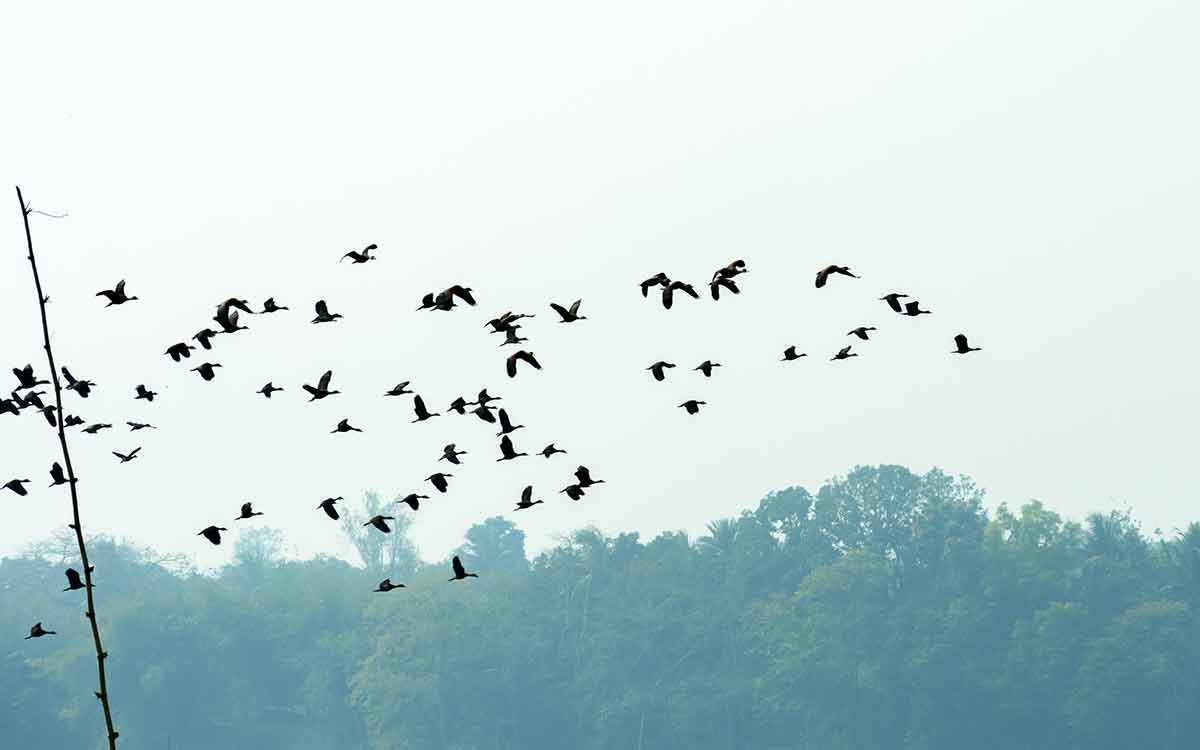
Namdapha is one of the largest and most biodiverse parks in India.
Covered with thick, pristine forests, the landscapes have habitats and ecosystems in which different types of flora and fauna thrive.
The Noa-Dohing river that flows through the park is a major tributary of the Brahmaputra and contains a wide variety of aquatic life.
Join a wildlife tour in the park to catch a glimpse of the red panda, snow leopard or the Himalayan black bear, along with bird watching and butterfly watching.
10- Go Trekking In Arunachal Pradesh
The terrain in Arunachal Pradesh consists of deep valleys with lush green forests and water streams flanked by highlands, ridges and snow-capped mountain peaks dotted with tiny villages and monasteries.
This makes the terrain perfect for trekking and exploring the natural beauty and local way of life.
There are many trekking trails like the Zero Valley, Thembang, Seven Lake trek and others.
Check the trek’s difficulty and the appropriate season before embarking on the trek.
11- Visit The Loktak Floating Lake in Manipur
Manipur is another Indian state renowned for its pristine and untouched landscapes and imposing Purvachal hills.
Like Arunachal and the other northeastern states, many beautiful places in Manipur are worth visiting.
Loktak Floating Lake is the largest freshwater lake in South Asia, famous for its floating islands, which change their shape and size throughout the year and attract visitors worldwide.
Western Ghats
The Western Ghats run from Gujarat to Kerala, parallel to the western coast of the Indian peninsula.
The average elevation of the ghats is 1200 m and the mountains are home to many famous hill stations such as Lonavala, Munnar and Ooty.
Rain-laden monsoons are obstructed by the Western Ghats, resulting in heavy rainfall in the western coastal region of the country.
Due to this phenomenon, Mumbai, Goa and the coastal regions of Karnataka and Kerala receive heavy rainfall from June to September. So, any travel to these regions during monsoons must be planned carefully.
Highest Peak: Anamudi (2,695 meters or 8,841 ft).
Things to do in the Western Ghats include:
12- Visit A Berry Farm In Mahabaleshwar, Maharashtra
Mahabaleshwar is a popular weekend getaway from Mumbai and Pune.
Famous for its cool weather in summer, Mahabaleshwar is well known for its berry farming, accounting for more than 80% of strawberry production in India.
When visiting the town, try the many local food specialities of the region, such as strawberries with cream, mulberries with cream, toffees, corn pattices and jellies.
13- Visit Coorg in Karnataka, the ‘Scotland of India’
Coorg is also popularly known as Scotland of India.
The hills and forests in this region are perpetually covered with a layer of mist and clouds giving it a mystical feel throughout the year.
The lush greenery and exotic views of Coorg can be enjoyed by visiting one of the many towns in this region like Madikeri, Virajpet and others.
The region is also famous for its various coffee and tea plantations, which are a must-visit due to their neatly manicured mountain slopes and exotic sceneries.
14- Visit The Munnar Hills In Kerala
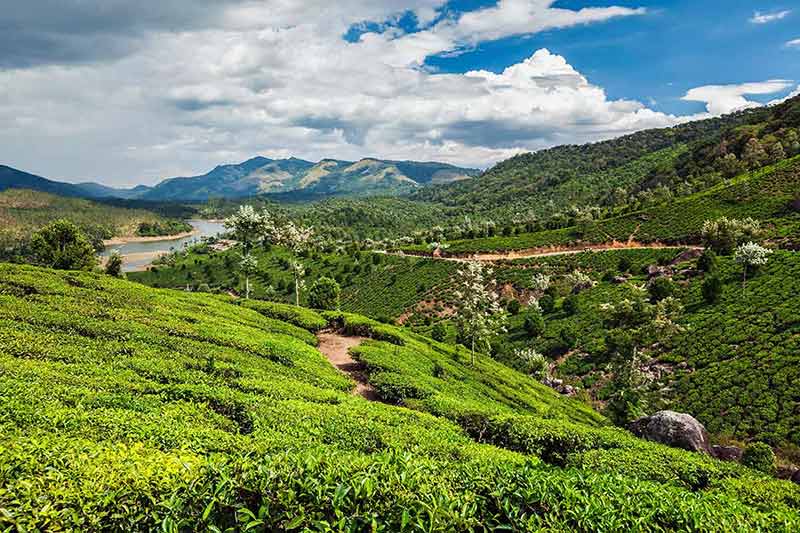
Munnar is a hill station nestled in the Western Ghats which attracts visitors from across the world.
Famous for its panoramic landscapes, lush greenery and tea estates, Munnar is also popular for its rare and exotic flowers like Neelakurinji, which bloom once every 12 years.
Many adventure activities like paragliding and boating attract visitors here.
The availability of luxury accommodation and proximity to other tourist destinations in Kerala, such as Alleppey and Thekkady, also make this hill station very popular among international travellers.
Aravalli Range
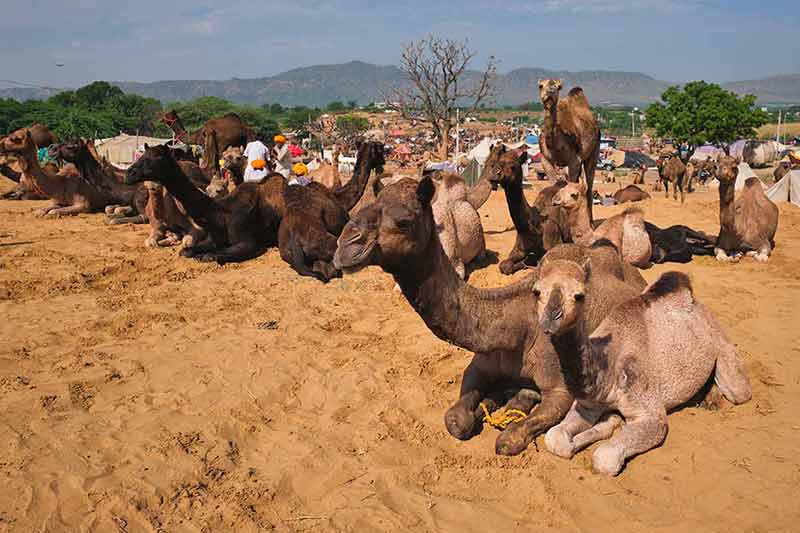
The Aravallis is the oldest mountain range in India and arguably the oldest mountain on Earth.
These mountains run from Gujarat to Rajasthan and block the rain-laded monsoons from reaching the Thar Desert in Rajasthan.
Udaipur (known as the city of lakes) is located on the southern slopes of the Aravallis and receives abundant rainfall during the monsoons.
You can find many forts and palaces in the mountains. Towns such as Bundi, Bera and Pushkar are tourist destinations popular for their rich royal history, forts and annual melas or town fairs.
Highest Peak: Guru Shikhar (1,722 meters or 5,649 ft).
Things to do in the Aravallis include:
15- Explore Dilawara Temple In Mount Abu
Mount Abu is the only hill station in Rajasthan and the perfect destination to beat the desert heat.
The hill station is also famous for Dilawara Temple, a pilgrimage site for followers of Jainism.
The temple is world renowned for its abundant use of marble and intricate carvings and stunning designs throughout the temple, including the ceilings.
Mount Abu is a five-hour drive and a weekend getaway from Ahmedabad in Gujarat.
16- Experience Royalty In Udaipur
Udaipur is also known as the city of lakes in Rajasthan and one of the more popular luxury destinations in Rajasthan.
Popular for its royal palaces and monuments, the city allows you to peek into the way of life of kings while staying at one of the exquisite palace-turned hotels.
Udaipur is also a part of the itineraries of luxury trains such as Palace on Wheels, Maharaja’s Express and the Deccan Odyssey.
17- Visit The Camel Fair In Pushkar
Pushkar is near Ajmer in Rajasthan and is a popular weekend getaway from Jaipur, famous for its Pushkar Mela, one of the biggest camel fairs in the country.
Thousands of camels are traded in this fair, and you can try a camel ride and shop for silverware, multi-coloured jewellery and traditional clothing.
You can also enjoy folk dances, food stalls, music festivals and even magic shows.
Eastern Ghats
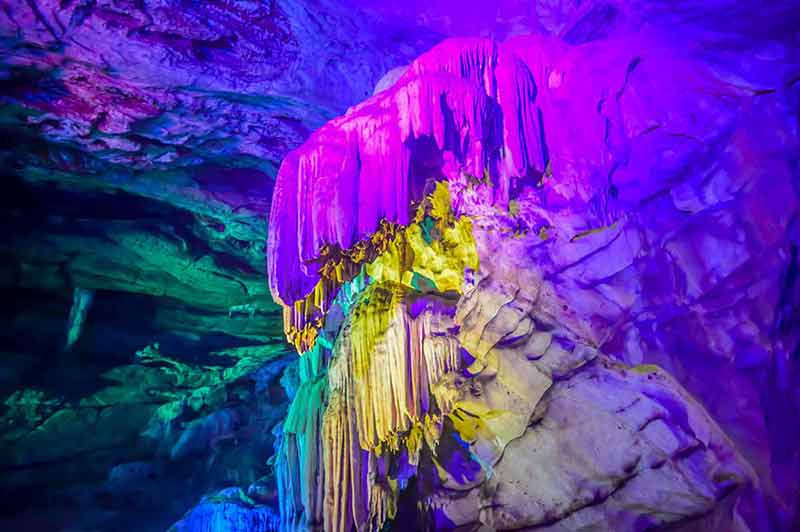
The Eastern Ghats run from West Bengal to Tamil Nadu, close to the eastern coast of the Indian peninsula.
These ghats are lower in elevation and older than the Western Ghats and are home to many National Parks and wildlife sanctuaries.
The famous perennial rivers in South India – Godavari, Krishna, Kaveri and many other rivers flow through the Eastern Ghats, and many beautiful cities are located on the banks of these rivers.
The town of Tirupati is situated on the Eastern Ghats and is a highly revered pilgrimage site for the Hindus.
Visakhapatnam and Bhubaneswar are some urban coastal areas that lie at the foothills of these ghats.
Highest Peak: Arma Konda (1,680 meters or 5,511 ft)
Things to do in the Eastern Ghats include:
18- Explore The Caves In Araku Valley, Andhra Pradesh
Araku Valley is a weekend destination from Visakhapatnam on the east coast of India.
You can explore the Borra caves, one of the largest cave systems in India, famous for their limestone speleothem structures (stalagmites and stalactites).
The location is also famous for adventure sports, waterfalls and coffee plantations.
You can travel to this region in a Vistadome train from Visakhapatnam railway station, which travels through 58 tunnels and 84 bridges en route to Araku.
19- Trek To The Summit Of Deomali Peak In Odisha
Popular for eco-tourism and trekking, Deomali is a perfect getaway to test your trekking skills and recharge your body.
Amidst lush green forests and misty mountain air, your trip to this beautiful peak will be rewarded with amazing views, fresh air, waterfalls and a peek into the tribal villages in these mountains.
20- Visit Shevaroy Hills In Tamil Nadu
This weekend destination near Bengaluru and Chennai is famous for its abundant greenery, coffee plantations and great weather.
A variety of spices and fruits are also grown in the surrounding hills, which are used to make local food preparations.
This quaint and untouched hill station is must visit if you want to explore the local areas away from tourists.
Vindhya and Satpura Ranges
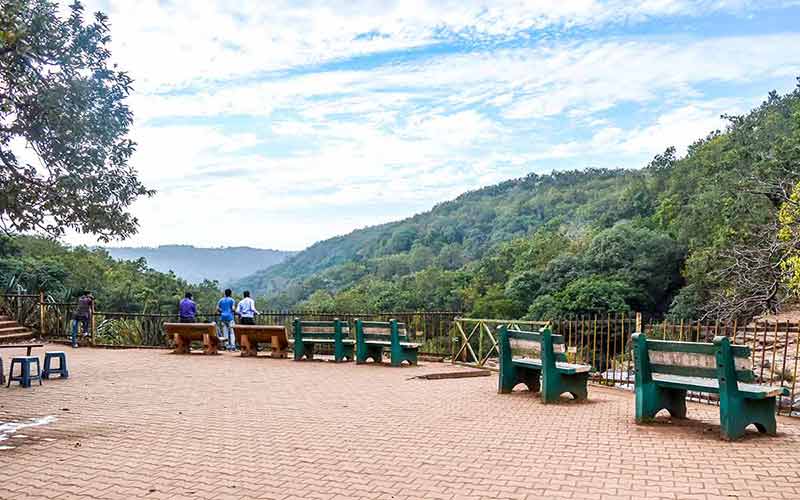
Vindhyas and Satpuras are mountain ranges that lie in central India and run parallel to each other. These mountains are predominantly inside the States of Madhya Pradesh and Maharashtra, with extensions to Gujarat, Chattisgarh and Uttar Pradesh.
There are a plethora of National Parks, forest reserves and wildlife trails in these ranges. Vindhya Ranges have been traditionally regarded as the boundary between Northern and Southern India.
The region around these mountains is blanketed with green forest covers and is a source of many rivers and waterfalls.
Highest Peak: Dhupgarh (1,350 meters or 4.430 ft)
Things to do in Vindyas and Satpuras:
21- Visit Kanha National Park, Madhya Pradesh
Kanha is one of India’s largest Tiger Reserves, known for conserving endangered wildlife.
The park has large populations of Royal Bengal Tigers, sloth bears, barasingha and other wildlife.
Kanha National Park is a perfect choice if you are looking for a getaway to explore wildlife amidst the mountains.
The Jungle Book, written by Rudyard Kipling, is popularly known to be based on the Kanha National Park in India.
22- Visit Panchmarhi Hills, Madhya Pradesh
Panchmarhi is the highest point in Madhya Pradesh, famous for its sandstone caves, beautiful waterfalls and adventure activities.
Trekking to the nearby Dhupgarh hill peak will be rewarded with mesmerising views of lush green surroundings and a picturesque sunset if you can time it correctly.
23- Visit Chikaldhara Hills, Maharashtra
Famous for its coffee plantations, Chikaldhara Hills is a weekend getaway from Bhopal and Nagpur.
Beautiful lakes dot this hill station, and you can explore the nearby Melghat Tiger Reserve by going on a jungle safari.
You can also visit the nearby forts if you have time.
The viewpoints and waterfalls near Chikaldhara are best visited during monsoons when abundant rainfall and the mountainside is covered with mist.
Mountains In India Weather
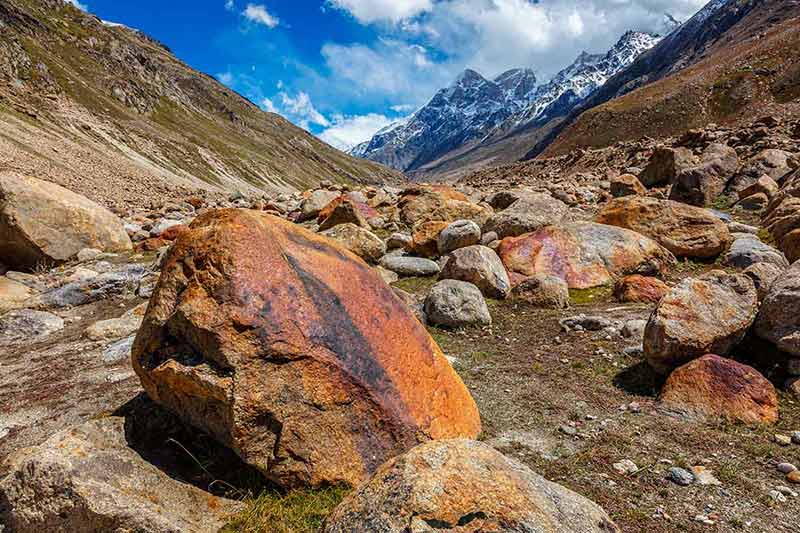
Mountains in India greatly influence the climate, weather conditions, and seasonal rain patterns in different parts of the country. The Himalayas act as a natural barrier for the warm monsoon clouds travelling north from the Indian Ocean during summer and prevent the cold winds from blowing south from the Tibetan Plateau in winter.
Most Indian states in the country’s south, northeast and northern parts receive abundant rainfall due to the monsoons. The Aravallis prevent the monsoon clouds from moving west towards the Thar Desert. The Western Ghats act as barriers for monsoons to move towards the east and cause heavy precipitation during the rainy season on the west coast.
The journey of monsoons in India starts in the month of June in Kerala. Through July, August and September, the monsoons travel from Kerala all the way to the Himalayas, where the mighty peaks block them.
November and December months see monsoons retreating from the Indian peninsula, and heavy rains can be seen in Northeast India and coastal cities in the Bay of Bengal. India’s west coast sees little rainfall during this period, and it becomes a perfect time for trekking and travelling to the Nilgiris and hills in the Western Ghats.
The Greater Himalayan ranges are closed from October due to heavy snowfall, while parts of the Middle and Outer Himalayas remain open for tourists. December to March is the perfect season for skiing in India’s Himalayan ski destinations such as Gulmarg, Auli, Solang and many others.
Travelling to the mountains in India makes for an exciting experience. Here are some tips to help you make your trip more memorable.
Top Tips When Exploring India’s Mountains
- When visiting high altitude regions, always make sure to carry medicine for altitude sickness, headaches and nausea.
- Roads in the Himalayan region can be quite intimidating to travel on but are generally safe as the drivers are very experienced.
- Roads in very high altitudes can be closed due to rockfalls or snowfalls, be sure to check if the roads are open before commencing your trip.
- Permits must be obtained before travelling to many mountain passes; some might not be open to foreigners.
- Many mountainous regions in central and southern India fall under National Parks and Protected Areas in India and entry can require permits.
- Do try the local food made from local and fresh ingredients
- Mountains are considered sacred in India; many even have temples and places of worship at their summits. Be considerate of local customs and rituals, and dressing requirements.
- 22 Palaces In India
- 28 Landmarks In India
- 22 Things To Do In Mumbai
- 20 Things To Do In Chennai
- Langar Etiquette
- Exploring Ajanta and Ellora Caves
- Ranthambore National Park Safari
- Kerala Kaleidoscope
- Kerala Backwaters
- 20 Things To Do In Hyderabad
- 20 Beaches In India
- Best Time To Visit India
- 20 National Parks In India
- 20 Smart Cities In India
- 20 Things To Do At Night In Delhi
- 15 Places To Visit In South India
- 10 Places To Visit In Delhi
- 10 Places To Visit In Kolkata
- 7 Places To Visit In India
- Brahmaputra River Cruise
- Ganges River Cruise
- Places To Visit In Jaipur
- Places To Visit In Udaipur
- Places To Visit In Jodhpur
- How Many Tigers Are Left In The World?
- 20 Drinks In India To Try
- Indian Street Food Guide
- A Guide To Mountains In India
- 20 Things To Do In Mumbai At Night
- Indian Christmas Travel
Plan Your Trip

Rent A Car – Find the best car rental rates at Discover Cars. They compare car hire companies to provide you with the best deal right now.

Find A Hotel – If you’re curious about this article and are looking for somewhere to stay, take a look at these amazing hotels.

